Flat Six
![]()
Flat Six |
|
by Stephan Wilkinson
|
This article appeared in the March 2001 issue of the Falco Builders Letter |
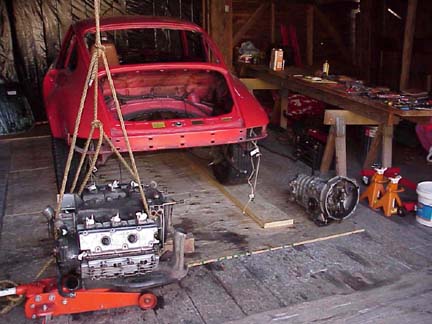
The orginal, grungy machine.
My wife gives great Christmas presents. And she has figured out how to do it without it costing her a thing. Her best presents are... permissions.
Sixteen years ago, her present was "permission to build a Falco." Two years ago, she upgraded me from a four-cylinder machine to an air-cooled flat six. "You look bored," Susan said. "The barn is empty, you sold the Falco, Merry Christmas, you have permission to restore a Porsche. You've always wanted to do that."
Not a Porsche-powered Mooney -- I'm pretty much through with serious flying -- but a classic 911, a car I've always loved. As a car writer, I've driven just about every Porsche model ever made -- 356s, 911s, 912s, 914s, 930 Turbos, 935 RSRs, 959s, 993s, 996s -- and even once got a racetrack ride in the flat-12, turbocharged, 1,200-horsepower Porsche 917, the most outrageously powerful sports-racer ever made. But I've never owned a 911.
Now I do. As soon as the snow melts and the mud magically turns to grass here in the Hudson River Valley, the product of my last two years of labor will roll out of our barn and onto the road. A yellowbird-yellow, black-on-black-interior 1983 Porsche 911 coupe that arrived here on a flatbed as a sadly neglected Guards red beater with a diarrhea-brown interior and an oily-but-running engine. In the interim, I have spent $60,000 making a brand-new $20,000 car. (Okay, I also inserted about 100 new horsepower, taking the engine from a 3.0-liter, primitively fuel-injected 180-hp to a 3.4-liter, twin-plugged, carbureted 280 or so, which should make it substantially faster than at least the early Porsche Turbos.)
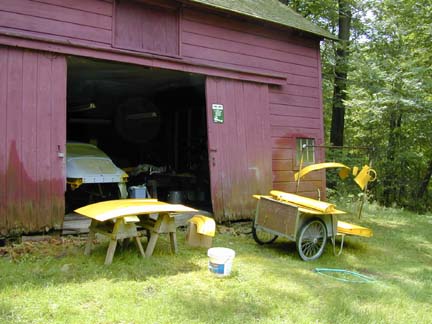
Where a Falco once birthed. Now, Steve has a Porsche restoration
in the barn.
Some people get it. Most don't. It's like the MasterCard ads: "Car, $10,500. Parts, $49,500. The experience, priceless."
What does this have to do with Falcos, other than the air-cooled flat engine? Well, in the great tradition of Falco builders everywhere, I Did It All Myself.
The car-restoration world is filled with people who boast that they "restored a Ferrari" or "rebuilt a Duesenberg." It usually turns out that they don't know a torque wrench from a tapemeasure, and all they actually did was sign checks. Checks to the engine overhauler, checks to the interior specialist, checks to the body shop, checks to the transmission rebuilder, checks to the upholsterer. Sort of like those guys who "build" Lancairs that they never actually touched in a workshop.
Like everybody reading this Builder Letter, I would rather have a good, competent machine-Falco, car, boat, motorcyle, model airplane -- that I built, rebuilt or restored all by myself than a perfect one that I paid somebody else to do for me. So I tore that puppy apart to the point where, with the remains of the Porsche's platform sitting on four jackstands, I could lift either end with what little strength a 64-year-old pencil-pusher could still summon. Then I started putting it back together.
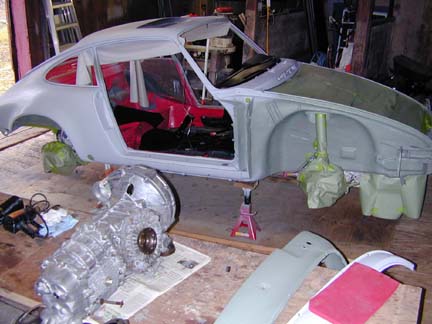
I rebuilt the transmission-first time I'd ever been inside one of those boxes, but it all made sense once I saw what was in there. I replaced every moving part on the chassis, most of the bushings with raceworthy, noncompliant polyurethane pieces that will provide a punishingly, delightfully harsh and noisy ride. I added trick adjustable anti-roll bars, heavier torsion arms and adjustable rear suspension arms. I gutted the interior, redyed the leather black, recarpeted everything and installed Recaro street/race seats.
And I rebuilt the engine.
A Porsche engine makes a Lycoming or a Continental look positively agricultural, and it's really nice to be dealing with a powerplant that isn't subject to monthly ADs announcing that 6,000 crankshafts need to be removed and junked because some moron in Williamsport went home for the weekend after forgetting to turn on the annealing oven, or whatever.
Some years ago, I replaced the crankshaft in my Falco's engine -- my fault, not Lycoming's -- and that, of course, involved disassembly/reassembly of the block. It was a scary prospect, since I had never done such a job before, but with the help of a watchful mechanic friend and Lycoming's so-called "Overhaul Manual," I did the job cleanly and carefully, and the engine ran just fine. Still is.
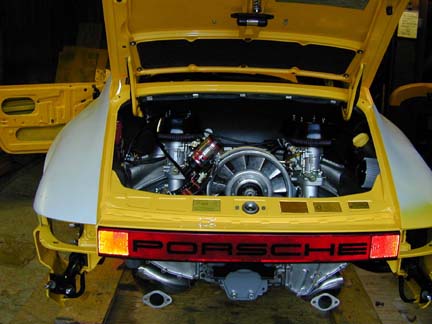
In fact, it's soon to power a brave professional ferry pilot on a flight from Portland, Oregon to Sydney, Australia, via a loop around the Aleutians, Midway and a variety of other islands. My Falco's owner, Bob Hendry, is an Ozzie and has moved back to the old sod after a hectic and rewarding sales career as one of Cisco's longest-term employees -- his badge numbered in the low hundreds -- and his Falco will follow him, God and a ferry tank willing.
But starting the Porsche's engine for the first time after its rebuild was far scarier than firing up the Falco. For one thing, a 911 engine is even more expensive than a Lycoming, particularly with the trick cylinders, pistons, cams and valves I'd installed. For another, the clearances, timings and working tolerances of a Porsche are more critical than a Lycoming's. Germans work in micrometers. Williamsportians work in give-or-take-a-few-thou.
Prime, crank (with one set of sparkplugs removed), get a good oil-pressure reading, replace the plugs, and stand by with the fire extinguishers and waterbuckets.
Why the five-gallon Spackle buckets filled with water? Because 35 years ago, when I was an enthusiastic Aston Martin DB-4 owner, I had a friend who spent two years building a very special DB-4 that he re-engined with one of the rare engines that Aston had built to race in, of all things, the Indy 500. Aston's venture went nowhere -- I don't think they even qualified a car -- but the leftover engines were about as strong a DB-4 straight-six as you could find.
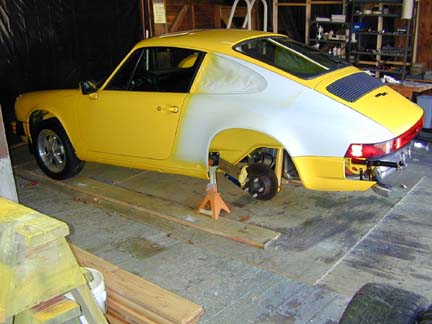
So Walter Jezewski worked for 24 months building the ultimate DB-4, and finally, one bitter-cold January evening, wheeled it out of his shop -- on the Upper East Side of Manhattan, which is about like having a hangar facing Central Park -- and tried to fire it up. Prime, crank, sputter, fart, pop, prime, crank, fart, backfire, BONFIRE.
Walter's very special DB-4 burned to the ground, its aluminum body literally melting. Nobody had thought to consider the consequences of a strong backfire through three flooded, double-throat Weber carburetors.
Well, I had two huge triple-throat PMO carbs (21st century Weber copies) on the 911, and I wasn't about to make that mistake. So I made sure to have a friend standing by the buckets while he watched for major first-start oil leaks. It was my neighbor Jim Catalano, who like me crosses vehicular lines: in one of his two rustic garages he has a rare Lotus Elite S2 that he restored, in the other is a 1930s Fleet biplane undergoing a total rebuild to join the J3 and Aeronca Defender that he's already flying.
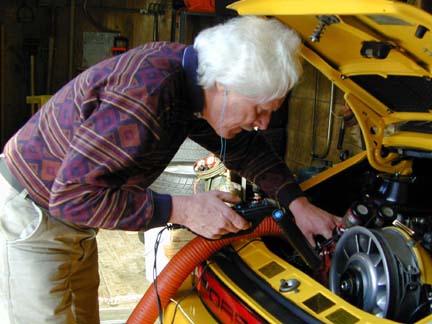
| "The strings hanging from my ears are attached to racer earplugs; I was timing the engine at 6,000 rpm and the noise is unbearable. (Actually, the engine is stopped in the photo, as you can see from the visible fanblades...)" |
We didn't need the water. The engine started just fine, although it was almost as complex a procedure as starting a radial. Racing carburetors have no chokes -- remember chokes? -- and there's no such thing as a primer on a car, so starting a carbureted engine in December involves a judicious amount of accelerator-pumping, cranking, re-cranking and persuading.
Finally, with only basic static ignition timing done, the engine came to life and grumbled through its stainless-steel headers and into a "muffler" that's more a collector box with twin four-inch-diameter outlet pipes. I was so thrilled I called my daughter at college -- she'll be the driver when we put the car on the track -- and made her listen to the bark.
And then I called my wife. After all, permission to restore the car had been her present to me. But wouldn't you know, busy magazine exec that she is, she was "in a meeting."
So I made her baffled secretary listen. "Ah, gee, that's
very nice, Mr. Wilkinson, I guess. I'll be sure to let Susan know"
|
|